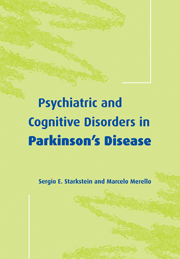Book contents
- Frontmatter
- Contents
- Preface
- 1 Introduction
- 2 Epidemiologic, clinical, and therapeutic aspects of Parkinson's disease
- 3 Parkinsonism and Parkinson's disease
- 4 Cognitive deficits in Parkinson's disease
- 5 Depression in Parkinson's disease
- 6 Anxiety, phobias, apathy, and premorbid personality in Parkinson's disease
- 7 Neuropsychologic and psychiatric side-effects of antiparkinsonian medication
- 8 Treatment of psychiatric disorders in Parkinson's disease
- Appendix
- References
- Index
8 - Treatment of psychiatric disorders in Parkinson's disease
Published online by Cambridge University Press: 13 August 2009
- Frontmatter
- Contents
- Preface
- 1 Introduction
- 2 Epidemiologic, clinical, and therapeutic aspects of Parkinson's disease
- 3 Parkinsonism and Parkinson's disease
- 4 Cognitive deficits in Parkinson's disease
- 5 Depression in Parkinson's disease
- 6 Anxiety, phobias, apathy, and premorbid personality in Parkinson's disease
- 7 Neuropsychologic and psychiatric side-effects of antiparkinsonian medication
- 8 Treatment of psychiatric disorders in Parkinson's disease
- Appendix
- References
- Index
Summary
In the preceeding chapters we revised the prevalence of psychiatric disorders and behavioral problems in PD. The consensus is that most patients with PD will become depressed at some point in their evolution, that both apathy and anxiety are frequent comorbid conditions of depression in PD, and that PD patients in the late stages of the illness may show a high frequency of delusions and hallucinations. Despite this high frequency of psychiatric disorders in PD, few studies have examined the usefulness of psychoactive drugs in a systematic way, and there is even less knowledge about the efficacy of other treatment modalities, such as psychotherapy or electroconvulsive therapy in these conditions. In this chapter we will examine the most useful treatment modalities for the different psychiatric disorders of PD, giving priority to controlled studies but discussing findings in open-label studies and case reports as well.
Treatment of depression in PD
Despite the high prevalence of depression in PD, which was reported to be about 40% in cross-sectional samples, most PD patients do not receive adequate antidepressant treatment. A survey of The Parkinson Study Group (Hegeman-Richard et al., 1997) revealed that only 26% of PD patients with depression included in their assessment received antidepressant treatment. In a 1- to 2-year follow-up study, Starkstein et al. (1992) found that only about 20% of the depressed PD patients received antidepressant treatment at some point during the follow-up period.
- Type
- Chapter
- Information
- Psychiatric and Cognitive Disorders in Parkinson's Disease , pp. 142 - 160Publisher: Cambridge University PressPrint publication year: 2002



